2021-04-04 new dummy added
INFO TO FOLLOW 
A SERIES
BALL


 Second specimen with a ring crimped primer
Second specimen with a ring crimped primer














 Specimen with cannelure also found on the A-Series.
Specimen with cannelure also found on the A-Series.  This specimen has 2 light punch marks on the left and right side of the date, the meaning for this is not known.
This specimen has 2 light punch marks on the left and right side of the date, the meaning for this is not known.
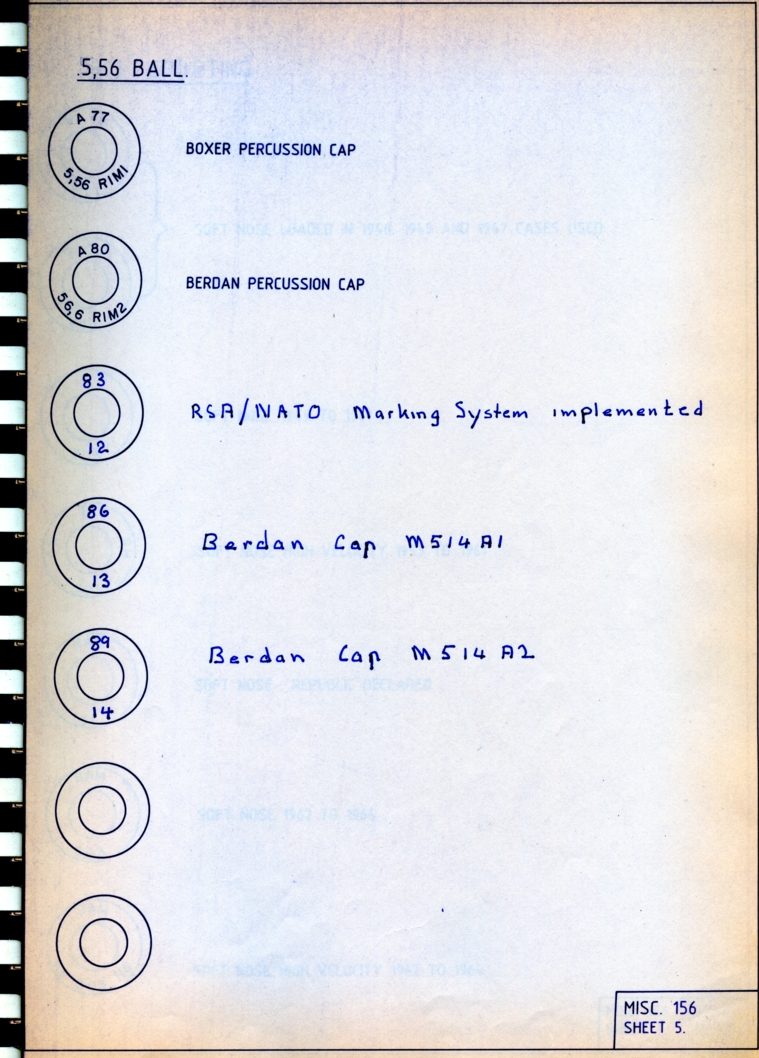 From the pamphlet “RSA Headstamp Markings”
From the pamphlet “RSA Headstamp Markings”
TRACER
The A79 Ball case is the earliest dated headstamp seen in tracer up to now. RSA 7.62 NATO tracer rounds all had the standard ‘G’ on the headstamp, but on the 5.56 the only distinguishing feature is the standard red P/A. Interesting to note however are the four different bullet variations on these early rounds.












DRILL/DUMMY










BLANK












GRENADE BLANK

 Red mouth seal
Red mouth seal
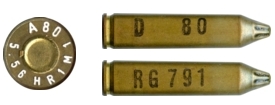


PROOF/WARMER
Warmer cartridges served almost the same purpose as proof loads, but are distinguished by a purple base/tip or both.











 Old version proof with honey coloured tip and p/a
Old version proof with honey coloured tip and p/a


 A82 version with Q denoting proof load and two different bullet variations.
A82 version with Q denoting proof load and two different bullet variations.
PORTUGUESE CONTRACT LOADINGS
 Proof or subsonic loading. Ordinary GM bullet.
Proof or subsonic loading. Ordinary GM bullet.
EXPERIMENTAL

 Double extractor groove. The purpose of this is not known. There is also a 7.62×39 RSA specimen of this.
Double extractor groove. The purpose of this is not known. There is also a 7.62×39 RSA specimen of this.

 All red with normal GM jacket. Purpose unknown. There is also a 7.62×39 RSA specimen of this.
All red with normal GM jacket. Purpose unknown. There is also a 7.62×39 RSA specimen of this.

 Grey painted GM jacket. There is a similiar 7.62×51 NATO version of this. It has been speculated that the 7.62 version was a target marking cartridge for competition purposes done on unit level.
Grey painted GM jacket. There is a similiar 7.62×51 NATO version of this. It has been speculated that the 7.62 version was a target marking cartridge for competition purposes done on unit level.

 Two experimental loads. The headstamp bunter was modified to remove the ‘R’ and ‘R1’. The meaning of this is unknown.
Two experimental loads. The headstamp bunter was modified to remove the ‘R’ and ‘R1’. The meaning of this is unknown.
STERILE AND SEMI STERILE SERIES
 No headstamp with purple p/a. Ordinary GM Bullet
No headstamp with purple p/a. Ordinary GM Bullet
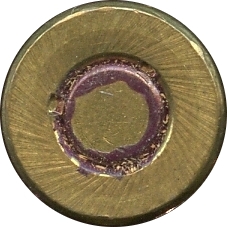 ‘milled’ base shown at 400%.
‘milled’ base shown at 400%.

 ‘milled base’. These can be found with clockwise and anti-clockwise milling.
‘milled base’. These can be found with clockwise and anti-clockwise milling.

 Police loads with ordinary GM bullet.
Police loads with ordinary GM bullet.
POST 1983 SERIES
As with the 7.62 NATO, 1983 saw the most significant change in ammunition manufacture in South Africa. This change affected the whole spectrum of ammunition manufacturing, from small arms ammunition up to naval ammunition. Medium, Large and Naval ammunition falls outside the scope of this project, but for small arms the changes were that all markings were simplified to a year of manufacture and an abbreviated model number that replaced the old manufacturer monogram, year, caliber, model and code letter that denoted the role of ammunition used. The following is from the booklet dealing with the changes from the pre 1983 to the post 1983 system. This is the same as were used for the 7.62 NATO.
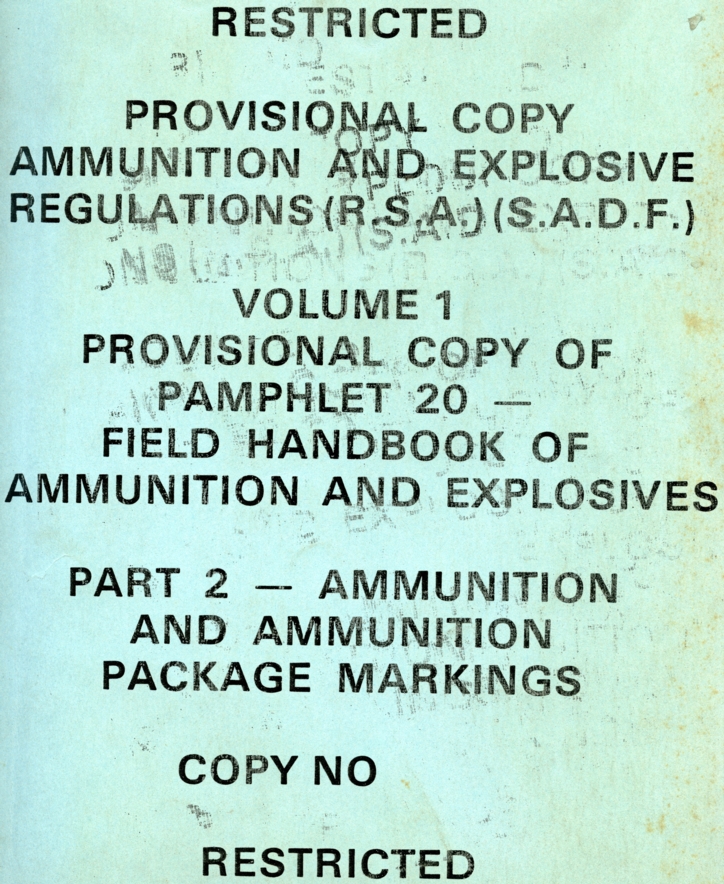
RESTRICTED
101
FIELD HANDBOOK OF AMMUNITION AND EXPLOSIVES
PART 2 – AMMUNITION AND AMMUNITION PACKAGE MARKINGS
CHAPTER 1 – FOREWORD
1. This handbook is designed to help the User identify ammunition, quickly and accurately, under field conditions.
SCOPE
2. It covers ammunition marked in the BSA, or marked overseas to RSA specifications. It does not cover imported ammunition marked to foreign specifications.
3. It covers the Pre 1983 and Post 1983 RSA ammunition markings systems .
ASSOCIATE PUBLICATIONS
4. Full details of the Pre 1983 system are given in “Joint Service Ammunition and Ammunition Package Markings”, a British publication on limited issue in the RSA.
5. A full technical manual is being prepared to cover the Post 1983 system.
6. This handbook gives a digest of the two systems for the benefit of the User.
BACKGROUND
7. The Pre 1983 RSA System Prior to 1983 ammunition was marked in accordance with a system the British introduced in 1960 and discontinued in 1969. The British changed their system partly because it became cluttered up with amendments, but mainly to conform to NATO specifications, which introduced a unified and simple system of colour coding to allow rapid identification of‘ ammunition by personnel of varied nationalities.
8. The RSA continued to use the British system after the British themselves had abandoned it, and RSA amendments and deviations were added. A point was reached where the system no longer met present day needs and a new RSA ammunition markings system was required.
9. The Post 1983 RSA System The NATO ammunition marking system has the advantages of clarity and simplicity and it was decided to introduce an RSA version which followed the NATO systems principals but which embodied alterations designed to meet RSA conditions.
10. The main changes introduced under the post 1983 system are as follows:
a. The pre 1983 system enforced rigid colour coding to indicate the “type” of ammunition, eg Dark Green = HE, Light Green = Smoke.
b. The post 1983 system uses a similar colour code but allows the use of alternative colours for camouflage, or other operational reasons, if the User requires this. These alternative colours have no meaning under the marking system and are called “non-significant colours” .
c. Where non-significant colours are used a system of coloured bands ere superimposed to indicate:
i. “Role” or “Target Effect”. eg Armour Defeating.
ii. “Hazard”, eg High Explosive Hazard or Low Explosive Hazard.
d. The pre 1983 use of the “red filling ring” to indicate the presence of an explosive filling or active agent is discontinued.
11. Further detail is given in Chapters 2 and 3. Examples of markings under the pre 1983 and post 1983 systems ere compared in the plates included in this handbook.
CHAPTER 2 – THE COLOUR CODING OF AMMUNITION
This chapter deals with the colour coding of mainly medium and large caliber ammunition and is not discussed here
CHAPTER 3 – MAIN IDENTIFICATION DETAILS
This chapter deals with filling codes, model numbers as well as lotting and batching, again medium and large caliber
CHAPTER 4 – 20MM, 30MM AND 35MM ROUNDS
Not discussed
CHAPTER 5 – SMALL ARMS AMMUNITION
ROLE IDENTIFICATION MARKINGS
1. Prior to 1983 differing roles of Small Arms Ammunition (eg. Ball, Blank, Tracer, etc.) were identified by the following means:
a. Bullet tip colour
b. Annulus colour
c. Code letter on the base of the cartridge case.
2. Under the post 1983 markings system the role of Small Arms Ammunition is identified by:
a. Bullet tip colour
b. Abbreviated model number on the base of the cartridge case.
3. The Annulus colour under the post 1983 markings system has no significance.
4. The significance of bullet tip, annulus colours and code letters under the Pre I983, and Post l983, systems is described in Table 4.
CARTRIDGE CASE BASE MARKINGS
5. Prior to 1983 the following information was stamped on a cartridge case base:
a. Monogram of manufacturer
b. The year of manufacture
c. The calibre
d. The model number
e. A code letter denoting the role of ammunition (not applicable to Ball ammunition)
6. with the introduction of the Post 1983 marking system the base markings are simplified to:
a. Year of manufacture
b. The abbreviated model number.
7. On ammunition with similar physical dimensions (eg. 9 mm x 19 and 9,65 mm x 19,5) the calibre may also be marked in addition to the year of manufacture and abbreviated model number.
MODEL NUMBER (POST 1983 MARKINGS SYSTEM)
8. Small Arms Ammunition model numbers, with the implementation of the Post 1983 markings system, follow the same basic format as described in Chapter 2 para 4. (Where “role” and “hazard” co-incide, for example with some HE filled items, a double band of the appropriate colour is used.).
9. The first numeral of the model number is used to denote the role of the ammunition, and is shown as follows:
a. Ball = M1 Series (eg. M1A1, M1A2 etc.)
b. Tracer = M2 Series (eg. M2A1, M2A2, etc.)
c. Armour-Piercing Incendiary = M3 Series (eg. M3A2, M3A3, etc.)
d. Blank = M4 Series (eg. M4A1, M4A2, etc.)
e. Rifle Grenade Launching Cartridge = M5 Series leg. M5A1, M5A2, etc.)
f. Observing (Spotter-Tracer ) = H6 Series (eg. M6A1)
g. Subsonic Ball = M10 Series (eg. M10A1)
h. Plastic Ball = M11 Series (eg. M11A1)
j. Ball Safety = M12 Series
k. High Pressure Proof = M13 Series (eg. M13A1, M13A2 etc.)
l. Drill = H14 Series
10. M7, 8, and 9 series will be allocated to other types of ammunition (eg. Incendiary, Armour Piercing} if these become applicable at a future date.
ABBREVIATED MODEL NUMBERS
11. To aid simplicity and economy in the markings process, the model number stamped on the base of the cartridge case is reduced to the two significant and changeable numerals in the model number format, the constant “M” and “A” letter not being shown. (eg. M1A1 is shown as 11, M1A2 is shown as 12, M2A2 is shown as 22, M3A3 is shown as 33, etc.)
AMMUNITION WITH DUAL ROLES
12. Ammunition with Dual Roles (eg. Spotter Tracer) has the bullet tip colour appropriate to the primary role, followed by a coloured band appropriate to the secondary role. Thus Spotter Tracer would have a yellow bullet tip (denoting a primary role of Observing), followed by a red band (denoting a secondary role of Tracer). Armour Piercing Incendiary Tracer (APIT) would have a silver bullet tip (denoting a primary role of Armour Piercing Incendiary) followed by a red band (denoting a secondary role of Tracer.)
CHAPTER 6 – NAVAL AMMUNITION
Not discussed here
CHAPTER 7 – AMMUNITION PACKAGE MARKINGS
To follow, together with Figures 1 – 3
TABLE 1 Colour coding of ammunition land and air service (other than S.A.A. and Projectiles 35mm and below) – not discussed
TABLE 2 Colour coding of Naval Ammunition (other than S.A.A. and Projectiles 35mm and below) – not discussed
TABLE 3 Colour coding of 20mm, 30mm and 35mm Ammunition – not discussed
TABLE 4 Colour coding and marking of small arms ammunition
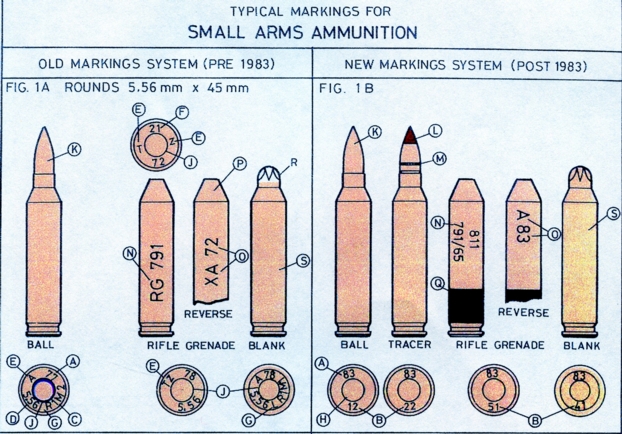
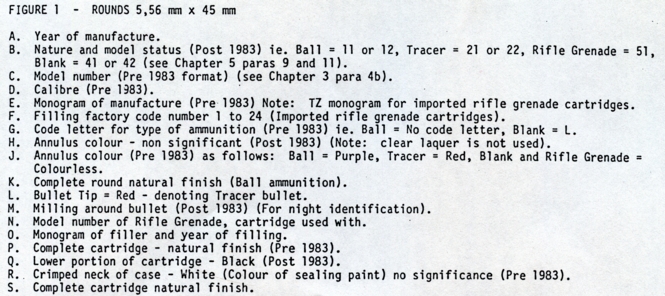
BALL
No M1A1 versions have been seen yet. As with the 7.62 NATO, M1A2 designation denotes ball powder loading.




 The last specimen has only 2 primer crimp marks
The last specimen has only 2 primer crimp marks









As can be seen on the RSA headstamp marking pamphlet, M1A3 and M1A4 are the designations used for the different primer caps. This change was observed on 1989 production.













 Reload
Reload







 P = Police
P = Police
SUB SONIC
 Ordinary GM bullet and the only distinguishing feature is the GREEN p/a
Ordinary GM bullet and the only distinguishing feature is the GREEN p/a
TRACER
The first dated tracers from the new series used standard Ball cases but there was a transition to the standard M2A2 headstamp during 1983. The first tracers also used the Portuguese bullet.



As far as could be ascertained, no 1984 dated tracer has been observed yet and it might even be possible that there was no production during that year.
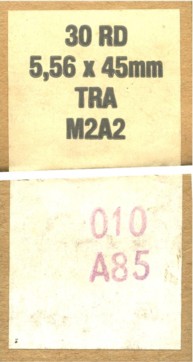


This clandestine tracer might have been made for special forces use, but it might also have been experimental. If the round was headstamped, it would have been 85 22 (M2A2) or 85 23 (M2A3). The transition date between M2A2 and M2A3 is unknown. Below is also a specimen that still used a ball case (M1A3)
 “Standard” RSA tracer used from 1985 onward with cannelure on bullet with cone crimping.
“Standard” RSA tracer used from 1985 onward with cannelure on bullet with cone crimping.



 No headstamped version manufactured in 1986. Case has the distinctive “milled base” as can also be seen on the chromed dummy below.
No headstamped version manufactured in 1986. Case has the distinctive “milled base” as can also be seen on the chromed dummy below.









 On the 97 case the bullet was plain, it is unknown why this was done.
On the 97 case the bullet was plain, it is unknown why this was done.


 Cannelured bullet used on case manufactured in 2000. It is unknown why an M1A4 designation would be used as tracer designation in South Africa was M2.
Cannelured bullet used on case manufactured in 2000. It is unknown why an M1A4 designation would be used as tracer designation in South Africa was M2.
TRACER DUMMY




TRACER EXPORT CONTRACT




Case with red coloured bullet has no P/A, and vice versa on the specimen with the red P/A.




RSA manufacture for Singapore
DUMMY/DRILL

















 This specimen has an empty GM Jacket
This specimen has an empty GM Jacket









PRESSURE TEST


ADVANCED SHOOTING PROJECTS



PMP




 Proof load with purple base and normal GM bullet
Proof load with purple base and normal GM bullet

 SS109
SS109



 Experimental? SS109. Base is half red.
Experimental? SS109. Base is half red.






 Ball, ordinary GM bullet
Ball, ordinary GM bullet

 Contract loads.
Contract loads.
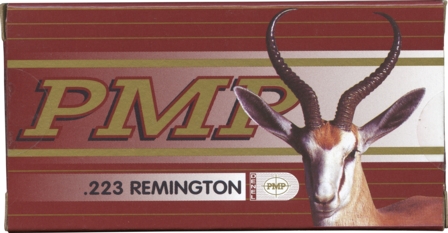 PMP/Denel commercial
PMP/Denel commercial

 These are the two commercial variations available from PMP at the moment.
These are the two commercial variations available from PMP at the moment.
 Safety Round.
Safety Round.
 Experimental APHC load with black tip. AP loadings are for export only.
Experimental APHC load with black tip. AP loadings are for export only.




Different PMP commercial headstamps. First specimen has the “light copper” primer. Second specimen has a brass primer with 3 stab crimps

 Pressure Test
Pressure Test

 Show dummy. The PMP has been overstamped by &&&
Show dummy. The PMP has been overstamped by &&&
BOSS

 Boss load from the late 80’s with typical blue p/a. Bullet has a very small soft nose
Boss load from the late 80’s with typical blue p/a. Bullet has a very small soft nose
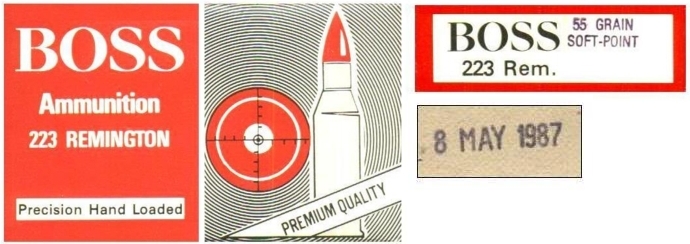
DENEL

 Laquered dummy from the 90’s
Laquered dummy from the 90’s

 This is the current headstamp by PMP that came on the market during late 2015.
This is the current headstamp by PMP that came on the market during late 2015.
OTHER










BLANK










 Normal and laquered display dummies
Normal and laquered display dummies





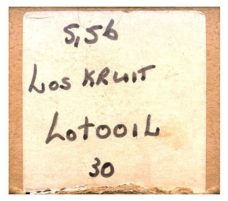








 Unfinished case
Unfinished case

 Contract for an unknown client. Mouth is sealed with a lilac paint, not laquer
Contract for an unknown client. Mouth is sealed with a lilac paint, not laquer



 Unfinished case
Unfinished case
GRENADE BLANK

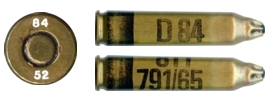

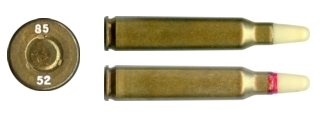
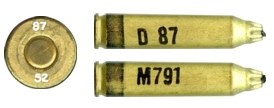




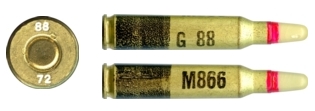



PROOF/WARMER






















 Interesting “PROOF” round. A specimen is immersed in a mercuric nitrate solution. Case is then inspected for flaws and irregularities. (See also the 7.62 NATO)
Interesting “PROOF” round. A specimen is immersed in a mercuric nitrate solution. Case is then inspected for flaws and irregularities. (See also the 7.62 NATO)
AP/APHC

 APHC. Experimental load. Bullet is also yellow, as per proof loads, but is distinguished with a tip that is magnetic, whereas proof loads are GM only
APHC. Experimental load. Bullet is also yellow, as per proof loads, but is distinguished with a tip that is magnetic, whereas proof loads are GM only

 AP dummy load. These black tipped loads were for export contracts. This version has a hollow GM core.
AP dummy load. These black tipped loads were for export contracts. This version has a hollow GM core.

 SS109 contract load
SS109 contract load





BUTTER
Designed to be an expanding bullet within a full metal jacket. Inside the jacket there is a lead base with a hollow point and a pin which extends to the bullet tip. The idea being that as the point hits the target the pin is forced back into the hollow point lead base, expanding it. To see how the design looks please see the 7.62×51 NATO loading for a cutaway. It is quite a scarce loading.
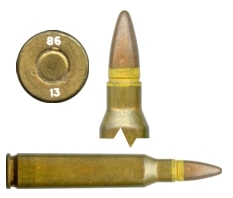
MANNA
This is one of the short range bullets that was adopted to a certain extent, mainly for police use as it lends itself to use in urban areas. The jacket wall is very thin and soft assisting in the break-up of the bullet in the target and preventing ricochets. Bullet weight is 3.56g (the same as that of the ball bullet)






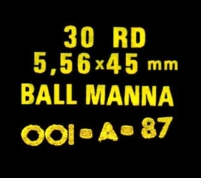

Label reads as follows:
1. Increased wounding capability
2. Improved accuracy
3. Limited penetration with better energy transfer
4. Eliminating target without endangering bystanders
MONAD


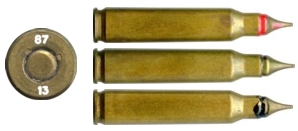




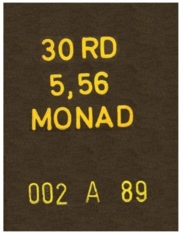

Label reads as follows:
1. Good penetration through hard targets eg. wood, steel and glass
2. Short stop capability
3. Very high wounding capacity
EXPERIMENTAL


SS109 loaded on ordinary ball case. The original neck seal is still visible, but the bullet is seated to a different depth. In the early to mid-80’s PMP experimented with SS109 projectiles pulled from FNB (Belgium) cases and loaded into commercial and military ball cases. Leaving the original green tip colour, other times the tip colour was cleaned off.

 Red painted GM jacket, purpose unknown.
Red painted GM jacket, purpose unknown.

 Unknown
Unknown
 Ordinary GM load.
Ordinary GM load.
_____
During the mid-1980’s the CSIR (Center for Scientific and Industrial Research – Pretoria) conducted a number of 5.56×45 short range experimentals utilizing composite plastic bullets.


_____




_____
 Primer sensitivity test
Primer sensitivity test



 Aluminium dummies by THOR Engineering.
Aluminium dummies by THOR Engineering.





This 5,56×45 Sub Cal. device was found at a PMP store that is being rented by NGA. Reloadable, the turned stainless steel body is drilled through with a ‘projectile’ cavity Ø 4.5 x 9mm deep. The body is turned parallel with a Ø 9.5mm ‘belt’ making up the base diameter. It was also featured in RSACCA 199. Also shown in 200% scale.
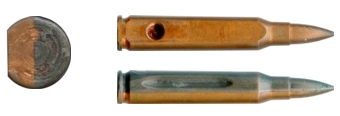
NGA






Two proof loads from an NGA box
OTHER CONTRACT LOADINGS
 National Police Administration (Taiwan)
National Police Administration (Taiwan)
